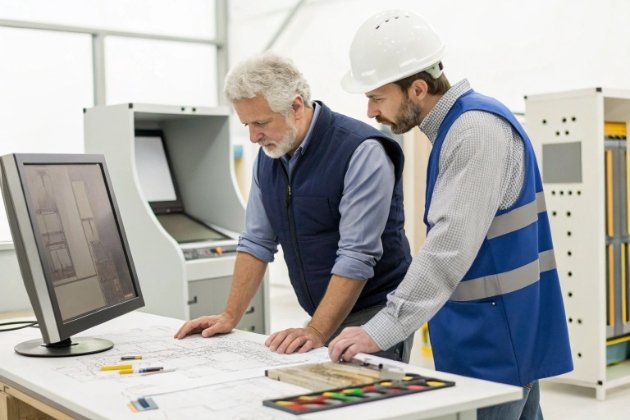When I first started sourcing slot machine cabinets, I worried that poor quality could hurt my business reputation and cause huge losses. I learned this lesson the hard way after receiving a batch that failed stress tests.
To ensure slot machine cabinets meet your quality requirements, always verify materials, design standards, and production processes. Reliable manufacturers perform strict quality checks, from material selection to pre-shipment inspection, ensuring every cabinet meets both performance and regulatory expectations.
The real challenge is finding a manufacturer that values quality control as much as you do. Let’s go through how I learned to secure consistent, reliable, and compliant slot machine cabinets that truly meet purchasing requirements.
How Do You Conduct Quality Assurance During Production?
I’ve found that quality assurance during production isn’t just a checklist—it’s a continuous process that starts long before assembly begins. When I visit factories, I always observe how the team tracks quality across every stage.
Manufacturers conduct quality assurance by implementing strict multi-stage inspections, including material verification, assembly checks, and stress testing. Each stage ensures the cabinet meets design, safety, and performance standards before final approval.

Understanding Quality Assurance Stages
A reliable manufacturer follows a structured process. It includes:
- Incoming material inspection
- Component compatibility testing
- Electrical safety and grounding checks
- Performance testing under real gaming conditions
- Final visual and functional inspection
Typical QA Process Breakdown
| QA Stage | Description | Purpose |
|---|---|---|
| Material Verification | Tests metals, coatings, and plastics | Confirms durability and safety |
| Assembly Check | Verifies component fit and wiring | Prevents defects and rework |
| Function Test | Operates cabinet with full load | Ensures stability and responsiveness |
| Burn-in Test | Continuous runtime test | Detects overheating and voltage issues |
| Final Inspection | Visual and documentation check | Confirms specs and compliance |
A professional QA system also includes corrective measures if any test fails. The manufacturer logs results for traceability and accountability. In my experience, those who follow structured quality management principles 1 deliver much more consistent results across orders.
Can I Request a Product Inspection Before Shipment?
I used to think factory inspections were only for big corporations, but I quickly learned they’re essential for any order size. Pre-shipment inspections saved me from costly surprises several times.
Yes, you can and should request a pre-shipment inspection before your slot machine cabinets leave the factory. These inspections verify design accuracy, electrical safety, stability, and overall build quality against the agreed specifications.

Why Pre-Shipment Inspections Matter
A pre-shipment inspection ensures the following:
- Cabinet dimensions match your drawings
- Electrical components are labeled and protected
- Game kits and interfaces are functional
- Paint, finish, and branding meet expectations
These checks are performed when production is complete but before packaging. You can send your own inspector or hire a third-party service such as SGS product inspection 2, TÜV factory auditing programs 3, or Intertek inspection services 4.
What Inspectors Typically Check
| Category | Test or Verification | Outcome |
|---|---|---|
| Electrical | Grounding, fusing, and current test | Safety confirmation |
| Mechanical | Door lock alignment, hinge strength | Stability check |
| Visual | Logo, artwork, screen alignment | Aesthetic validation |
| Functional | Game responsiveness, button feedback | Operational readiness |
| Packaging | Protective materials, labeling | Safe transport assurance |
A detailed inspection report often includes photos, test data, and defect classifications. I always review these before issuing the final payment. It’s a small cost compared to the peace of mind it brings.
How Do You Ensure the Cabinet Meets My Specific Requirements?
Every project I’ve worked on had its own set of requirements—custom dimensions, control layouts, or game interfaces. Without a clear communication process, even the best manufacturer can miss critical details.
To ensure your cabinets meet specific requirements, provide detailed design files, 3D visualizations, and material preferences. Professional manufacturers use prototype approval, real-time progress updates, and documentation reviews to align production with your expectations.

Communication and Documentation
Your purchasing requirements should include:
- CAD drawings or reference photos
- Bill of materials (BOM)
- Electrical schematics
- Component specifications
- Surface finish samples
The more details you provide, the fewer misunderstandings will occur. In my case, having a 3D design visualization 5 before production began eliminated 90% of potential errors.
Key Elements to Align Before Production
| Step | Action | Benefit |
|---|---|---|
| Design Confirmation | Approve design mockups and dimensions | Ensures accuracy |
| Prototype Review | Receive a sample or prototype | Validates ergonomics and aesthetics |
| Material Verification | Approve coating, buttons, lighting | Guarantees consistency |
| Functional Alignment | Test interfaces and ports | Confirms usability |
| Production Updates | Receive video/photo updates | Monitors real progress |
Consistent communication keeps your supplier accountable. I’ve learned that weekly production reports and mid-stage video calls are extremely effective in maintaining quality alignment.
Can I Request Additional Quality Checks During Production?
At first, I thought quality checks during production might slow things down. Later, I realized they actually prevent expensive rework.
Yes, you can request additional in-line quality checks during production to monitor progress and ensure compliance. These mid-production inspections assess assembly accuracy, component integrity, and electrical performance before final assembly.

How Mid-Production Checks Work
Manufacturers often divide production into key stages—cutting, welding, assembly, and wiring. Independent or in-house inspectors check quality at each milestone. This way, defects are caught before they multiply.
Common In-Production Checkpoints
| Stage | Quality Focus | Benefit |
|---|---|---|
| Frame Construction | Structure, weld quality | Prevents frame misalignment |
| Painting | Coating thickness, color matching | Ensures visual consistency |
| Component Installation | Wiring layout, connector fit | Prevents electrical issues |
| Function Setup | LED and sound test | Detects early malfunctions |
| Final Tuning | Button response, touchscreen calibration | Ensures gameplay quality |
I usually request three-stage inspections: early, mid, and final. The manufacturer provides detailed photos or videos showing progress. This helps me feel confident before I pay the remaining balance.
Long-Term Benefits of Ongoing Quality Checks
Regular inspections create trust and reduce waste. Over time, the manufacturer develops a clear understanding of your standards. This leads to faster delivery, better communication, and a consistent product line.
To keep cabinets compliant across different markets, factories often rely on CE safety requirements 6 and UL electrical standards 7, especially when exporting to multiple regions.
For material consistency, many manufacturers reference ASTM material testing methods 8 to validate coatings, metals, and plastics before cabinet assembly.
Conclusion
Consistent quality doesn’t happen by accident—it’s the result of planning, communication, and trust between buyer and manufacturer. Reliable factories also ensure compliance by following international regulations such as RoHS environmental standards 9 and maintaining structured production workflows similar to ISO-based quality systems 10.
Footnotes
1. Quality management systems improve QC consistency. ↩︎
2. SGS provides global pre-shipment inspections. ↩︎
3. TÜV audits ensure compliance during production. ↩︎
4. Intertek offers manufacturing inspection services. ↩︎
5. 3D design tools help verify cabinet layouts. ↩︎
6. CE guidelines regulate product safety in the EU. ↩︎
7. UL standards ensure electrical and fire safety. ↩︎
8. ASTM standards validate material durability. ↩︎
9. RoHS reduces hazardous materials in electronics. ↩︎
10. ISO standards support structured quality systems. ↩︎


